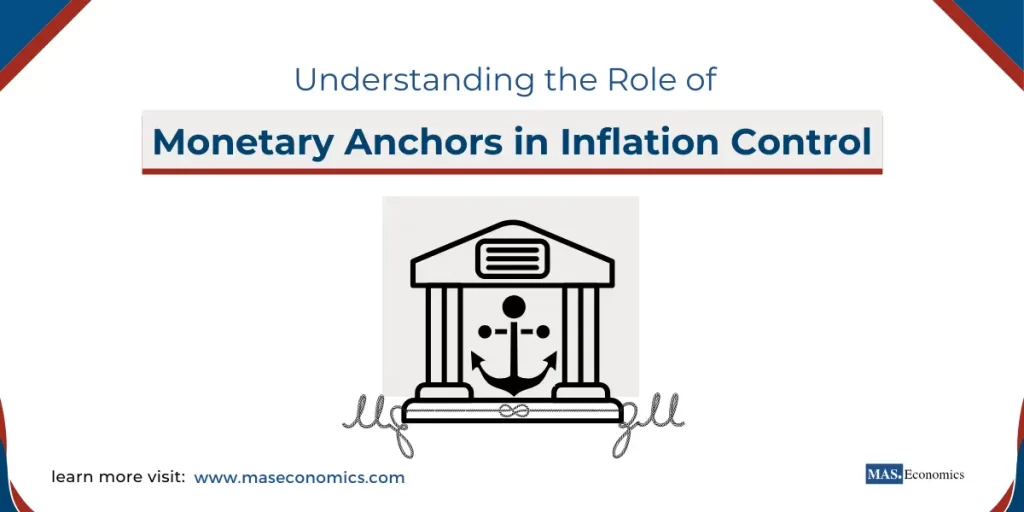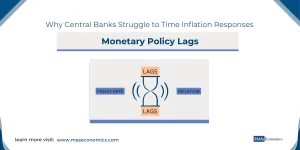The stability of an economy often depends on the effectiveness of its inflation control mechanisms. One such crucial tool is the use of monetary anchors. This blog post explores how nominal wage anchors and exchange rate anchors can be used to stabilize inflation and promote economic stability. Anchors provide a reference point for economic policies, which can help mitigate inflationary pressures and curb price instability.
The Concept of Monetary Anchors in Inflation Control
A monetary anchor is a benchmark used by central banks to stabilize the overall price level within an economy. Traditionally, central banks may use a variety of anchors—such as monetary aggregates, nominal exchange rates, or inflation targeting—to prevent runaway inflation or deflation. In this context, nominal wage anchors and exchange rate anchors are essential to stabilize price levels, either by directly limiting inflation or indirectly managing the expectations that drive inflationary pressures.
The Nominal Wage Anchor
Understanding the Wage Anchor
The nominal wage anchor functions by stabilizing wage growth in such a way that it aligns with productivity and inflation targets. According to the wage norm approach, nominal wages should grow at a rate that matches the productivity gains plus the inflation target set by the central bank. If productivity grows by 1.5% and the target inflation rate is 2%, then the nominal wage should increase by approximately 3.5% to stabilize the economy.
This anchor is effective because unit labor costs play a significant role in determining price levels. If wages grow in line with productivity, unit labor costs will remain stable, which in turn helps in controlling inflation. A stable growth path of wages is key to preventing both inflationary spirals and deflationary pressures. Nominal wage anchors serve as an internal stabilizer for an economy, providing a clear reference point that prevents extreme fluctuations in prices.
The Role of Wage Norms
Wage norms are critical to the effectiveness of the nominal wage anchor. These norms suggest that wages should ideally increase based on the sum of productivity growth and a predetermined inflation rate. This approach ensures that the real wage remains aligned with productivity, thereby keeping inflation under control without stifling growth.
For instance, in many Western economies, a target inflation rate of around 2% is common, while productivity growth may vary from country to country. In economies where wages follow this structured growth, inflation tends to remain more predictable and easier to control. This model has been effective in stabilizing economies across Europe, where social partners—governments, employers, and trade unions—work together to agree on reasonable wage increases.
Challenges in Implementing Wage Anchors
However, implementing a nominal wage anchor is not always straightforward. Several factors can destabilize wage anchoring, including labor market dynamics, political pressures, and external shocks like sudden increases in commodity prices. For example, during the oil crises of the 1970s, nominal wages increased significantly to compensate for the higher cost of living, which then led to a wage-price spiral. Such spirals occur when increased wages lead to higher prices, which then prompt demands for even higher wages.
This highlights the importance of maintaining discipline in wage settings, particularly during economic shocks. Wage-setting systems that allow for rapid increases in wages without regard to productivity gains are more likely to lead to inflationary pressures. Therefore, ensuring the stability of wage growth—especially during periods of economic uncertainty—is crucial for using nominal wages as an effective anchor.
The Exchange Rate Anchor
The Dynamics of Exchange Rate Anchors
An exchange rate anchor operates by pegging the domestic currency to a more stable foreign currency, thus providing an external standard for price stability. When a country adopts a fixed exchange rate regime, it helps limit fluctuations in import prices, which in turn stabilizes domestic prices. This is particularly effective in countries that are highly dependent on imports, as a stable exchange rate reduces the volatility of import costs and, by extension, the general price level.
Exchange rate anchors are particularly useful in open economies where trade forms a substantial portion of economic activity. By fixing the exchange rate, central banks can effectively control one of the main channels through which inflation enters the economy—imported inflation. For instance, many smaller economies have pegged their currency to the U.S. dollar or the euro to maintain price stability.
Real-World Examples of Exchange Rate Anchors
A classic example of the effective use of an exchange rate anchor is the success of several Latin American countries in controlling hyperinflation during the 1990s. Countries like Argentina and Brazil adopted exchange rate anchors as part of their stabilization programs, which helped bring down inflation rates from hundreds or even thousands of percent to more manageable levels. By pegging their currency to a stable foreign currency, these countries managed to import price stability, reduce inflation expectations, and restore economic confidence.
Similarly, in the Eurozone, countries that joined the monetary union effectively adopted the euro as an exchange rate anchor. This brought about significant price stability for participating nations, especially those with historically high inflation rates. By adopting the euro, these countries were able to benefit from the European Central Bank’s focus on price stability, leading to a more stable economic environment.
Challenges and Risks of Exchange Rate Anchors
Despite their effectiveness, exchange rate anchors also come with risks. A significant challenge is maintaining the peg, particularly when economic fundamentals diverge from those of the anchor currency. For example, if inflation in the domestic economy is higher than that of the anchor country, maintaining the fixed exchange rate could lead to a loss of international competitiveness, currency reserves, and eventually a currency crisis.
The 1997 Asian Financial Crisis serves as a cautionary tale. Several Southeast Asian countries had pegged their currencies to the U.S. dollar, which worked well while their economies were booming. However, when economic conditions changed, these countries found it increasingly difficult to maintain their currency pegs, leading to devaluations, capital flight, and severe economic crises. This underlines the importance of aligning domestic economic policies with the requirements of maintaining a stable exchange rate anchor.
Comparing Nominal Wage and Exchange Rate Anchors
Both nominal wage anchors and exchange rate anchors have proven effective in stabilizing inflation, but their suitability depends largely on the specific economic context of a country.
Nominal Wage Anchors
More suitable for economies with strong labor institutions and relatively closed markets. They help align domestic cost pressures with productivity gains, preventing wage-price spirals. Countries like Germany have successfully used wage moderation policies, driven by coordinated wage bargaining, to maintain low inflation.
Exchange Rate Anchors
More effective in economies that are highly open to trade or have experienced hyperinflation. They provide an external standard of stability and are often used when domestic monetary institutions lack credibility. Countries like Hong Kong and Denmark have successfully used exchange rate pegs to maintain price stability, providing a clear signal to markets and consumers.
Policy Recommendations
To leverage monetary anchors effectively, policymakers should consider the following recommendations:
Strengthening Institutional Frameworks
Effective use of wage and exchange rate anchors requires strong institutional frameworks. For wage anchors, this includes robust labor market institutions that can negotiate wages in a way that aligns with productivity and inflation targets.
Maintaining Flexibility
While anchors provide stability, they should not be rigid. For example, exchange rate anchors should include a mechanism to allow adjustments during economic shocks. Similarly, wage anchors should be implemented with an understanding of macroeconomic conditions to avoid triggering wage-price spirals during crises.
Targeted Communication
Effective communication of policy objectives is crucial. Whether using a wage or exchange rate anchor, central banks must clearly communicate their targets and the reasoning behind them to build credibility and manage expectations.
Conclusion
Both nominal wage and exchange rate anchors serve as powerful tools for controlling inflation, provided they are implemented and managed effectively. Wage anchors align internal cost dynamics with productivity, while exchange rate anchors offer external stability by pegging to a stable foreign currency. The choice of anchor depends on the specific needs and structure of an economy, as well as the challenges it faces.
FAQs
What is the purpose of a monetary anchor in inflation control?
A monetary anchor serves as a benchmark for central banks to stabilize the price level and curb inflation. Anchors like nominal wage or exchange rate targets help keep inflation expectations in check and prevent runaway inflation by providing clear guidelines on how certain economic variables (like wages or exchange rates) should behave to maintain stability.
How does a nominal wage anchor help control inflation?
A nominal wage anchor stabilizes inflation by aligning wage growth with productivity gains and inflation targets. By keeping wage increases within the bounds of productivity, a wage anchor helps prevent wage-price spirals, where rising wages lead to higher prices and further wage demands, ultimately controlling inflationary pressures within the economy.
What are the benefits and challenges of using wage norms as a monetary anchor?
Wage norms, which base wage growth on productivity and target inflation rates, prevent unsustainable wage increases that could lead to inflation. However, implementing wage norms can be challenging due to factors like labor market dynamics, political pressures, and unexpected external shocks (e.g., commodity price surges) that disrupt wage stability.
How does an exchange rate anchor help stabilize inflation?
An exchange rate anchor pegs the domestic currency to a stable foreign currency, reducing exchange rate volatility and stabilizing import prices. This is particularly beneficial for open economies that rely heavily on imports, as a stable exchange rate reduces the impact of imported inflation on the overall price level.
What are some real-world examples of successful exchange rate anchors?
Countries like Argentina and Brazil used exchange rate anchors in the 1990s to curb hyperinflation, pegging their currencies to the U.S. dollar to stabilize prices and inflation expectations. Similarly, some European countries stabilized their economies by adopting the euro, benefiting from the European Central Bank’s commitment to price stability.
What are the risks associated with exchange rate anchors?
Exchange rate anchors can pose risks if the domestic economy diverges significantly from the anchor currency’s economy. For example, if domestic inflation is higher than in the anchor country, maintaining the peg may hurt competitiveness and deplete currency reserves. This can lead to currency crises, as seen in the 1997 Asian Financial Crisis when countries struggled to maintain pegs to the U.S. dollar amid changing economic conditions.
How do policymakers choose between a nominal wage anchor and an exchange rate anchor?
The choice depends on the specific economic context. Nominal wage anchors are more effective in relatively closed economies with strong labor institutions, where wage moderation can stabilize inflation. Exchange rate anchors are often preferred in open economies reliant on trade, or where there is a need to build monetary policy credibility by pegging to a stable currency.
Thanks for reading! Share this with friends and spread the knowledge if you found it helpful.
Happy learning with MASEconomics




